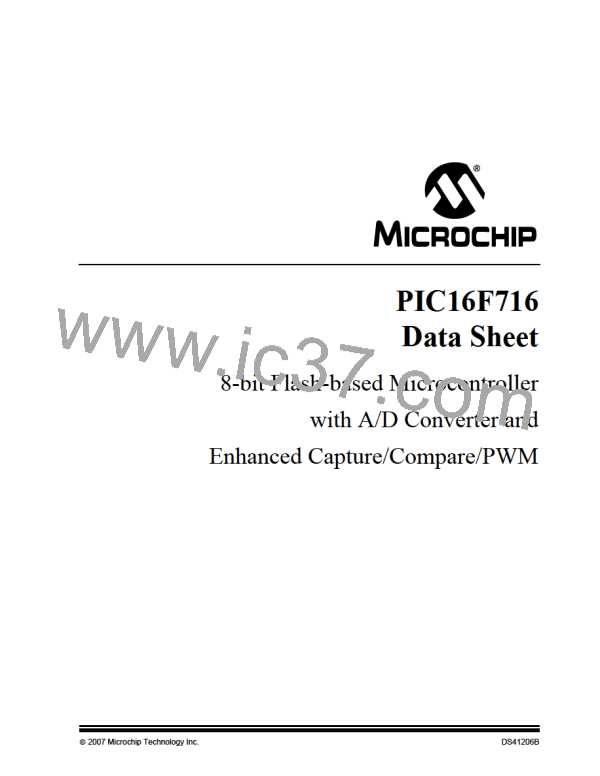PIC16F716
EXAMPLE 2-2:
HOW TO CLEAR RAM
USING INDIRECT
ADDRESSING
2.5
Indirect Addressing, INDF and
FSR Registers
The INDF register is not a physical register. Addressing
INDF actually addresses the register whose address is
contained in the FSR register (FSR is a pointer). This is
indirect addressing.
MOVLW 0x20
MOVWF FSR
CLRF INDF
INCF FSR
;initialize pointer
;to RAM
;clear RAM & FSR
;inc pointer
NEXT
BTFSS FSR,4 ;all done?
EXAMPLE 2-1:
INDIRECT ADDRESSING
GOTO
NEXT
;no, clear next
;yes, continue
CONTINUE
• Register file 05 contains the value 10h
• Register file 06 contains the value 0Ah
• Load the value 05 into the FSR register
:
An effective 9-bit address is obtained by concatenating
the 8-bit FSR register and the IRP bit of the STATUS
register, as shown in Figure 2-4. However, IRP is not
used in the PIC16F716.
• A read of the INDF register will return the value of
10h
• Increment the value of the FSR register by one
(FSR = 06)
• A read of the INDR register now will return the
value of 0Ah.
Reading INDF itself indirectly (FSR = 0) will produce
00h. Writing to the INDF register indirectly results in a
no-operation (although Status bits may be affected).
A simple program to clear RAM locations 20h-2Fh
using indirect addressing is shown in Example 2-2.
FIGURE 2-4:
DIRECT/INDIRECT ADDRESSING
Direct Addressing
from opcode
Indirect Addressing
RP1:
7
RP0
6
0
0
IRP
FSR register
(2)
(2)
bank select
location select
bank select
location select
00
01
80h
10
100h
11
00h
180h
(3)
(3)
Data
Memory
(1)
7Fh
Bank 0
Note 1: For register file map detail see Figure 2-2.
FFh
17Fh
Bank 2
1FFh
Bank 3
Bank 1
2: Maintain clear for upward compatibility with future products.
3: Not implemented.
DS41206B-page 18
© 2007 Microchip Technology Inc.

 MICROCHIP [ MICROCHIP ]
MICROCHIP [ MICROCHIP ]